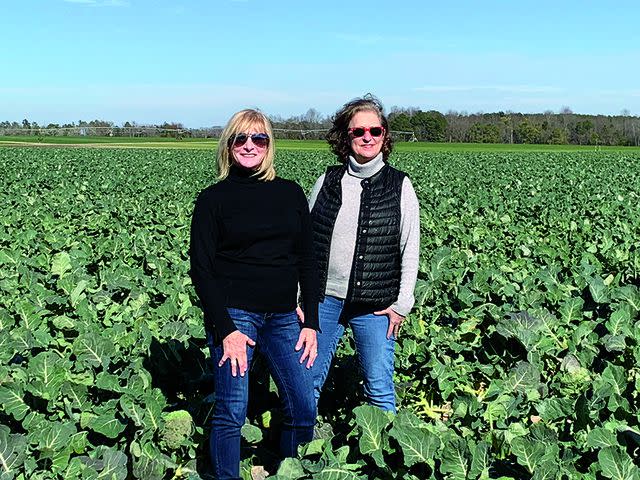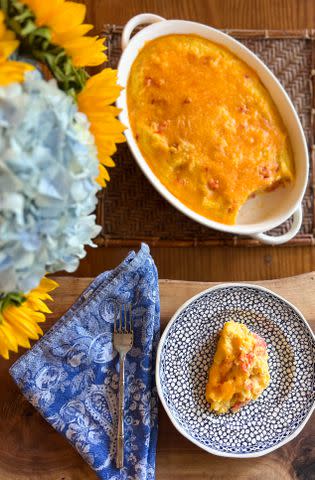New Cookbook Welcomes All To The Southern Jewish Table
'Kugels & Collards' chronicles the Jewish experience in South Carolina through oral histories and recipes.

"We have learned that food provokes strong memories, uncovers little known histories, and brings forth voices silenced in the past," writes authors Rachel Gordin Barnett and Lyssa Kligman Harvey in the introduction to their new book Kugels & Collards: Stories of Food, Family, and Tradition in Jewish South Carolina.
The book, which uses oral histories and recipes to chronicle the history of South Carolina's Jewish communities, began as a blog of the same name but expanded into a cookbook that includes more than 50 stories and 80 recipes. Harvey came up with the original name of the project, whittling it down from “Knishes, Kugels, and Collards,” to the pithy title it has today.
Kugels & Collards doesn’t read like most new cookbooks; instead, it feels closer to a family photo album, gathering snapshots of several generations of Jewish South Carolinians, their historic businesses, stories of immigration and assimilation, as well as plenty of recipes.
It came together during the pandemic, when the pair conducted interviews with Jewish families across the state over Zoom, collecting memories to include alongside family recipes, just as they had on the blog. A few uniting themes emerged.
"There seemed to be this thread that went through the book…there were so many shared experiences and it gave me a sense of this wonderful community,” says Barnett. This was particularly poignant for her, as she grew up in the only Jewish family in the small town of Summerton, South Carolina.

Through recipes, the authors capture the history of the Southern Jewish table, including how traditional dietary rules would often butt up against the coastal state's prolific use of shellfish and pork—neither of which are Kosher. They also trace the evolution of a specific Southern Jewish cuisine, which is just as likely to include collards (sans the ham hock) as it is brisket.
Southern staples like black-eyed peas were commonly incorporated into Jewish cooking through African-American South Carolinian women working in Jewish homes. As Barnett and Harvey collected recipes and stories from the local Jewish community, they quickly realized that they needed to acknowledge the labor and contributions of the African-American women in defining Southern Jewish cuisine.
The acknowledgement comes through recipes and memories of figures like Charlestonian Annie Gailliard, who, beginning in 1933, worked in the home of Harvey’s grandparents. She made three meals a day for the family, and the only requirement was that the food be Kosher; otherwise the menu was up to her. Included in Kugels & Collards is her okra gumbo, which she made without any pork or shellfish. Annie became a part of Harvey’s family, and her recipes, by extension, a part of their family history that Harvey wanted to include in the book's collection.
""We have learned that food provokes strong memories, uncovers little known histories, and brings forth voices silenced in the past,” writes authors Rachel Gordin Barnett and Lyssa Kligman Harvey."
The okra gumbo, along with many other recipes in the book, were passed down orally until the authors committed them to paper for this project. Recipes were recreated and shot in Barnett’s home for the book, furthering the sense that these dishes came from home cooks. The hardest part of the project was narrowing down the recipes to include.
"Everyone’s mother makes the best chopped liver," Barnett jokes.
In fact, one story in the book entitled, "Passover Chopped Liver Wars" chronicles competing recipes. The story comes from Jake Bialos, the New Yorker husband of a South Carolina native, and describes the three different chopped liver recipes he encounters while spending Passover with his wife’s family in the South. Each one highlights a different family member's take, from super creamy, to more eggy, to even a ‘mock’ liver made without meat.
His story, and the many others in the book, illustrate both how diverse and yet cohesive the Southern Jewish table is, and how the table continues to evolve generation after generation.

Emily Brown
Grits and Lox Casserole from Kugels & CollardsKugels & Collards is out now. You can order a copy, and try out the recipe for Grits And Lox Casserole (above) from the book.
For more Southern Living news, make sure to sign up for our newsletter!
Read the original article on Southern Living.

